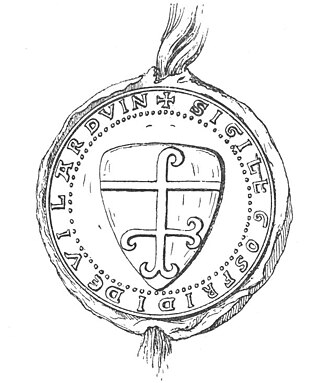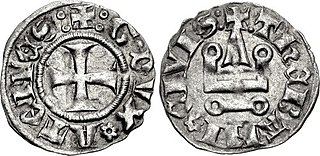Related Research Articles

Charles I, commonly called Charles of Anjou, was a member of the royal Capetian dynasty and the founder of the second House of Anjou. He was Count of Provence (1246–1285) and Forcalquier in the Holy Roman Empire, Count of Anjou and Maine (1246–1285) in France; he was also King of Sicily (1266–1285) and Prince of Achaea (1278–1285). In 1272, he was proclaimed King of Albania, and in 1277 he purchased a claim to the Kingdom of Jerusalem.

Year 1272 (MCCLXXII) was a leap year starting on Friday of the Julian calendar.

Charles II, also known as Charles the Lame, was King of Naples, Count of Provence and Forcalquier (1285–1309), Prince of Achaea (1285–1289), and Count of Anjou and Maine (1285–1290); he also styled himself King of Albania and claimed the Kingdom of Jerusalem from 1285. He was the son of Charles I of Anjou—one of the most powerful European monarchs in the second half of the 13th century—and Beatrice of Provence. His father granted Charles the Principality of Salerno in the Kingdom of Sicily in 1272 and made him regent in Provence and Forcalquier in 1279.

The Principality of Achaea or Principality of Morea was one of the three vassal states of the Latin Empire, which replaced the Byzantine Empire after the capture of Constantinople during the Fourth Crusade. It became a vassal of the Kingdom of Thessalonica, along with the Duchy of Athens, until Thessalonica was captured by Theodore, the despot of Epirus, in 1224. After this, Achaea became for a while the dominant power in Greece.

The Duchy of Athens was one of the Crusader states set up in Greece after the conquest of the Byzantine Empire during the Fourth Crusade as part of the process known as Frankokratia, encompassing the regions of Attica and Boeotia, and surviving until its conquest by the Ottoman Empire in the 15th century.

William of Villehardouin was the fourth prince of Achaea in Frankish Greece, from 1246 to 1278. The younger son of Prince Geoffrey I, he held the Barony of Kalamata in fief during the reign of his elder brother Geoffrey II. William ruled Achaea as regent for his brother during Geoffrey's military campaigns against the Greeks of Nicaea, who were the principal enemies of his overlord, the Latin Emperor of Constantinople Baldwin II. William succeeded his childless brother in the summer of 1246. Conflicts between Nicaea and Epirus enabled him to complete the conquest of the Morea in about three years. He captured Monemvasia and built three new fortresses, forcing two previously autonomous tribes, the Tzakones and Melingoi, into submission. He participated in the unsuccessful Egyptian crusade of Louis IX of France, who rewarded him with the right to issue currency in the style of French royal coins.

Walter V of Brienne was Duke of Athens from 1308 until his death. Being the only son of Hugh of Brienne and Isabella de la Roche, Walter was the heir to large estates in France, the Kingdom of Naples, and the Peloponnese. He was held in custody in the Sicilian castle of Augusta between 1287 and 1296 or 1297 to secure the payment of his father's ransom to the Aragonese admiral Roger of Lauria. When his father died fighting against Lauria in 1296, Walter inherited the County of Brienne in France, and the counties of Lecce and Conversano in southern Italy. He was released, but he was captured during a Neapolitan invasion of Sicily in 1299. His second captivity lasted until the Treaty of Caltabellotta in 1302.

Philip I of Taranto, of the Angevin house, was titular Latin Emperor of Constantinople by right of his wife Catherine of Valois–Courtenay, Despot of Romania, King of Albania, Prince of Achaea and Taranto.

Geoffrey I of Villehardouin was a French knight from the County of Champagne who joined the Fourth Crusade. He participated in the conquest of the Peloponnese and became the second prince of Achaea.

Geoffrey II of Villehardouin was the third prince of Achaea. From his accession to the princely throne, he was a powerful and respected person, and even French knights came to the principality to enter his service. Geoffrey II emerged as the most powerful vassal of the Latin Empire of Constantinople, the person around whom the crusaders' states in modern Greece gradually regrouped themselves. He came to the rescue of the imperial capital three times. As a reward of his services to the Latin Empire, he was granted suzerainty over the island of Euboea by his brother-in-law, Emperor Baldwin II of Constantinople (1228–1261). He was also a humane prince, benevolent and just, solicitous for the condition of the common people.
The Treaty of Viterbo was a pair of agreements made by Charles I of Sicily with Baldwin II of Constantinople and William II Villehardouin, Prince of Achaea, on 24 and 27 May 1267, which transferred much of the rights to the defunct Latin Empire from Baldwin to Charles.
Narjotde Toucy was the son of Philip of Toucy and of Portia de Roye. Narjot was therefore the grandson of his namesake who died in 1241.

Florent of Hainaut was Prince of Achaea from 1289 to his death, in right of his wife, Isabella of Villehardouin. He was the son of John I of Avesnes and Adelaide of Holland. From his father he received the stadholdership (government) of Zeeland.

Isabella of Villehardouin was reigning Princess of Achaea from 1289 to 1307. She was the elder daughter of Prince William II of Achaea and of his third wife, Anna Komnene Doukaina, the second daughter of Michael II Komnenos Doukas, the despot of Epiros.
Philip of Lagonesse was an official of Charles I of Sicily.
Guy I de la Roche (1205–1263) was the Duke of Athens, the son and successor of the first duke Othon. After the conquest of Thebes, Othon gave half the city in lordship to Guy.

Guy II de la Roche, also known as Guyot or Guidotto, was the Duke of Athens from 1287, the last duke of his family. He succeeded as a minor on the death of his father, William I, at a time when the duchy of Athens had exceeded the Principality of Achaea in wealth, power, and importance.
William I de la Roche succeeded his brother, John I, as Duke of Athens in 1280. He was the son of Guy I de la Roche.
Philip, of the Capetian House of Anjou, was the second son of King Charles I of Sicily and Countess Beatrice of Provence. He was at various times set up to become King of Sardinia, Prince of Achaea or King of Thessalonica, but ultimately ascended no throne.
The bailli, bailie, or bailiff was the administrative representative of the Princes of Achaea, ruling the Principality of Achaea in the Prince's absence. The early princes, who belonged to the founding Villehardouin dynasty, resided in the principality, and governed it directly. In 1278, Achaea passed to Charles of Anjou, the King of Naples. Charles, and many of his successors, ruled the principality through their baillis, and never visited it in person. Originally, the baillis were Angevin officials, but the post was often given to powerful feudatories from Achaea and the rest of Frankish Greece.
References
- 1 2 3 Runciman, Steven (1958). The Sicilian Vespers . Cambridge University Press. ISBN 0-521-43774-1.
- 1 2
- Longnon, Jean (1969) [1962]. "The Frankish States in Greece, 1204–1311". In Setton, Kenneth M.; Wolff, Robert Lee; Hazard, Harry W. (eds.). A History of the Crusades, Volume II: The Later Crusades, 1189–1311 (Second ed.). Madison, Milwaukee, and London: University of Wisconsin Press. pp. 234–275. ISBN 0-299-04844-6.